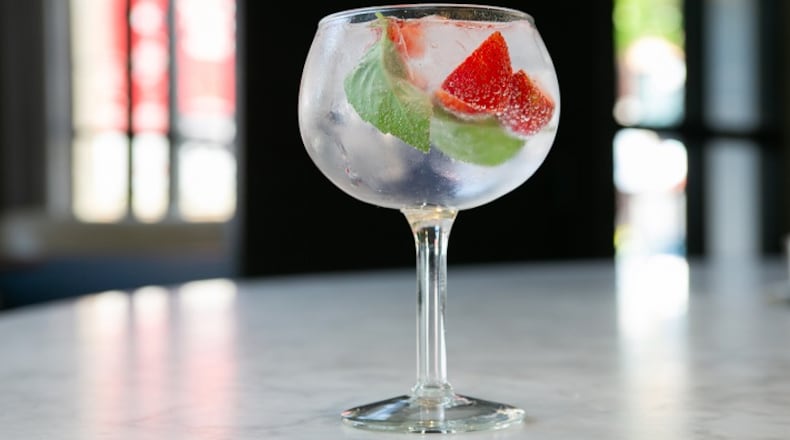The gin-and-tonic craze in Spain is nothing new. For years, locals have used the drink to create a lovely pause in the day, and tourists have followed suit. The Spanish cocktail barely resembles the highball from the American corner bar, often made from cheap gin topped with syrupy tonic from the soda gun. In Spain, the gin tonic — a truncated form of ginebra y tonico — is a thing. On a recent trip to Madrid, Barcelona and Valencia, we enjoyed gin tonics everywhere, from food shows to market halls, hotel bars to neighborhood taverns.
The technique: Building the cocktail is a big part of the Spanish gin tonic experience. First, the bartender must select the proper oversized goblet and add large cubes of ice individually. The ice gets stirred with a bar spoon to chill the glass as the patron ponders the choice of gin, which is added — generously — next. Garnishes must be slapped or pinched to release their aromas as they tumble in. Finally, the tonic is poured slowly down the twisted handle of the spoon to increase the bubbles and enhance the aromatic effect of the botanicals.
At our favorite hangout in the Lavapies neighborhood of Madrid, we loved watching the sleepy bartender become mesmerized by his own careful stirring. Many bars serve the tonic in its own bottle on the side, allowing the guest to pour in tonic at leisure, pondering the ratio as the ice melts on a hot afternoon al aire libre.
The gin: Spanish distilleries are proliferating faster than tourists visiting la Sagrada Familia. Companies fight for market share by introducing unique versions of the spirit, and even the humblest bar carries several selections. Our favorites included Nordes Atlantic Galician Gin, which is distilled from grapes; Gin Mare, whose Mediterranean botanicals include Arbequina olives and resinous herbs; the uberpopular Larios; and Siderit, a newer player in the gin game whose lineup includes a column-distilled pink gin infused with hibiscus flower. (Pink gin is also a thing. Strawberry and hibiscus versions are very popular in Europe and Great Britain — a trend to watch for in coming months.)
The tonic: Schweppes made from cane sugar is the mixer standard in much of Europe, and in Spain, it comes in lots of interesting regional flavors, including “pink” (flavored with currant, introduced as a less bitter way to consume gin tonic), pink peppercorn, hibiscus and matcha. Mixologists mix and match the botanicals in the gin with the flavor profiles of several brands of tonic waters from around the continent.
The garnish: Purists may scoff at the variety of fruits, herbs, spices and vegetables that are added to gin tonics, but we adore the way the flavors of the garnish compliment the botanicals in the gin and the style of the tonic. We watched as dozens of items were muddled into the mix. At a bohemian bar in the Raval area of Barcelona, the caftan-clad proprietor shuffled back to the kitchen to fetch blackberries every time a guest ordered a gin tonic; the berries added a memorable color and flavor that was worth the trouble. Bay leaves, fresh herb leaves, citrus peel, grapes (particularly with Gin Mare), strawberries, cucumber ribbons, whole spices — all create a delightful aroma in the glass.
Josh Relkin, head bartender at Chicago’s Proxi, amped up his gin tonic research while on his honeymoon in Spain (in fact, he was on the trip when he was offered his job at Proxi). He now offers four variations on his cocktail menu. His strawberry-strewn version features Citadelle, a French gin, and serves as a great example of what Relkin says he learned abroad: “A gin tonic is more than just a gin and tonic.”
“Citadelle gin’s super bright acidity shows lemon and grapefruit, but rather than garnishing with citrus peel, I wanted to show a progression of flavor,” Relkin says. “In my mind, the flavor of lemon leads to macerated strawberries, which makes me think of fresh basil, then pink peppercorns.”
Relkin’s most unique gin tonic discovery happened in Barcelona: a saffron gin tonic infused with orange peel and cardamom. “Here, saffron is a luxury ingredient, and there, it turns up in an everyday drink,” he says.
Life lessons from Spain, in a goblet.
About the Author
The Latest
Featured

